Short Answer Essay on Leadership
VerifiedAdded on 2022/11/25
|8
|1728
|288
AI Summary
This article discusses the concept of transformational leadership in nursing practice and its application in the healthcare field. It explores the four components of transformational leadership and the benefits it brings to organizations and followers. The article also highlights the importance of leadership style in job satisfaction among nurses. It concludes with a discussion on servant leadership as a model for healthcare organizations.
Contribute Materials
Your contribution can guide someone’s learning journey. Share your
documents today.
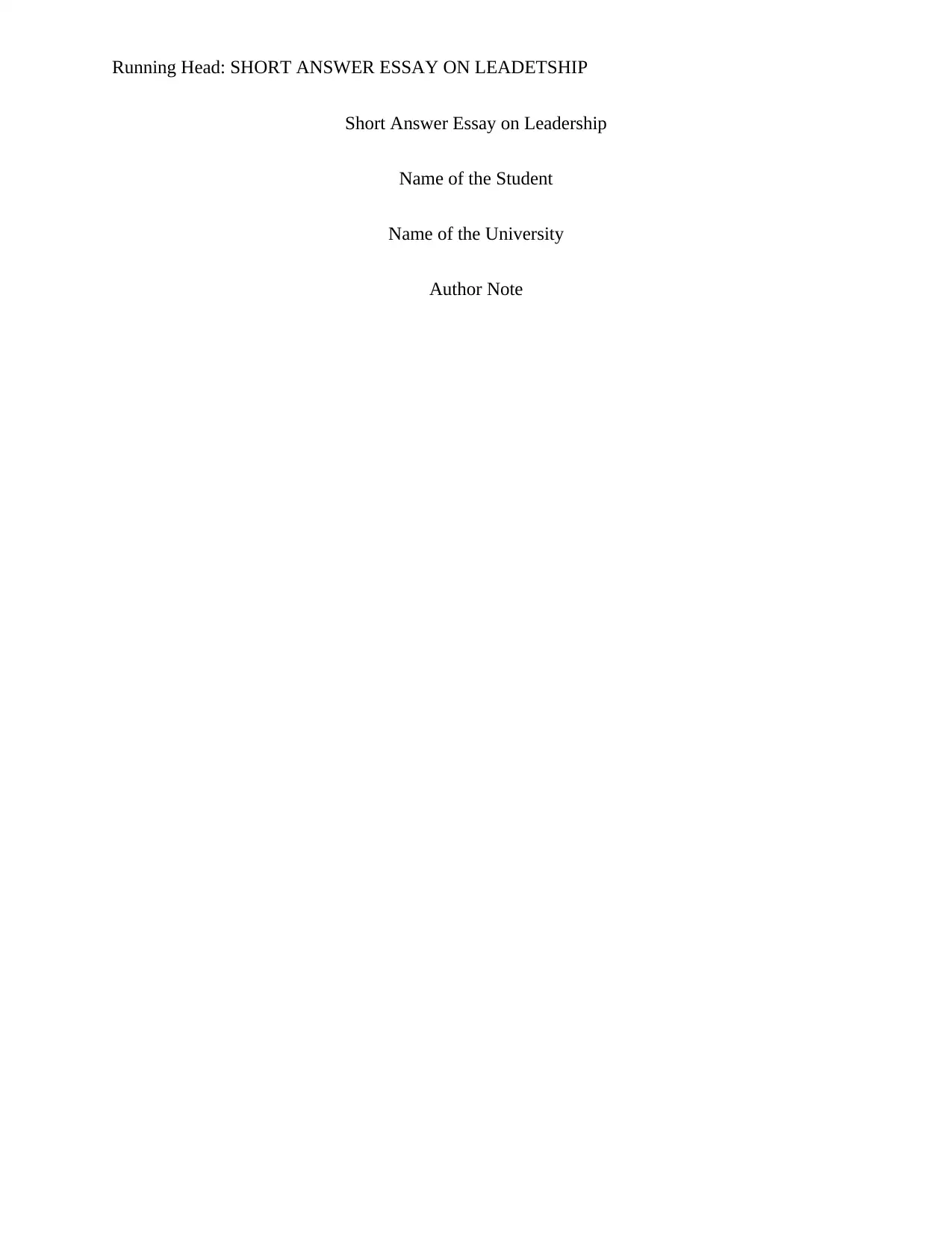
Running Head: SHORT ANSWER ESSAY ON LEADETSHIP
Short Answer Essay on Leadership
Name of the Student
Name of the University
Author Note
Short Answer Essay on Leadership
Name of the Student
Name of the University
Author Note
Secure Best Marks with AI Grader
Need help grading? Try our AI Grader for instant feedback on your assignments.
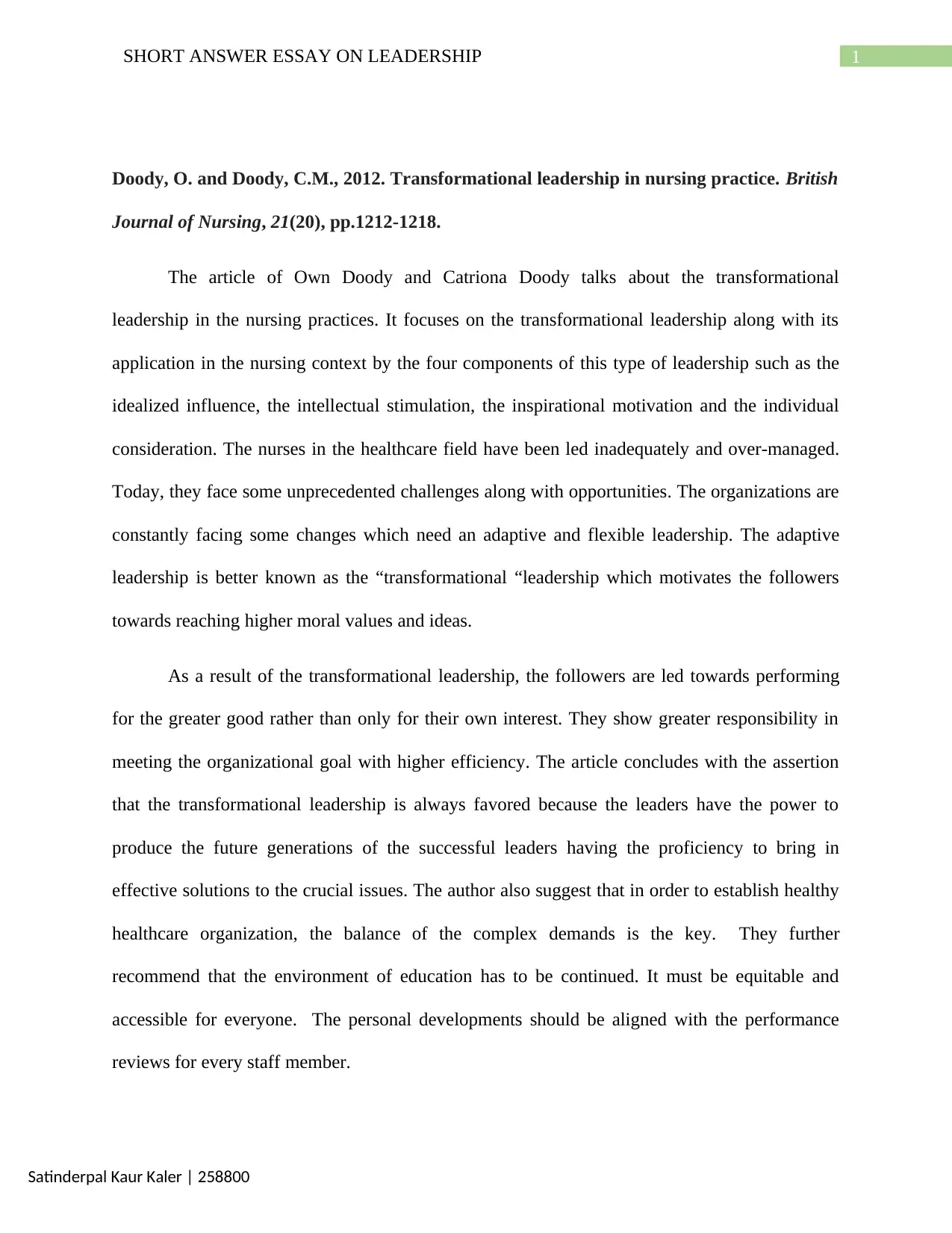
1SHORT ANSWER ESSAY ON LEADERSHIP
Satinderpal Kaur Kaler | 258800
Doody, O. and Doody, C.M., 2012. Transformational leadership in nursing practice. British
Journal of Nursing, 21(20), pp.1212-1218.
The article of Own Doody and Catriona Doody talks about the transformational
leadership in the nursing practices. It focuses on the transformational leadership along with its
application in the nursing context by the four components of this type of leadership such as the
idealized influence, the intellectual stimulation, the inspirational motivation and the individual
consideration. The nurses in the healthcare field have been led inadequately and over-managed.
Today, they face some unprecedented challenges along with opportunities. The organizations are
constantly facing some changes which need an adaptive and flexible leadership. The adaptive
leadership is better known as the “transformational “leadership which motivates the followers
towards reaching higher moral values and ideas.
As a result of the transformational leadership, the followers are led towards performing
for the greater good rather than only for their own interest. They show greater responsibility in
meeting the organizational goal with higher efficiency. The article concludes with the assertion
that the transformational leadership is always favored because the leaders have the power to
produce the future generations of the successful leaders having the proficiency to bring in
effective solutions to the crucial issues. The author also suggest that in order to establish healthy
healthcare organization, the balance of the complex demands is the key. They further
recommend that the environment of education has to be continued. It must be equitable and
accessible for everyone. The personal developments should be aligned with the performance
reviews for every staff member.
Satinderpal Kaur Kaler | 258800
Doody, O. and Doody, C.M., 2012. Transformational leadership in nursing practice. British
Journal of Nursing, 21(20), pp.1212-1218.
The article of Own Doody and Catriona Doody talks about the transformational
leadership in the nursing practices. It focuses on the transformational leadership along with its
application in the nursing context by the four components of this type of leadership such as the
idealized influence, the intellectual stimulation, the inspirational motivation and the individual
consideration. The nurses in the healthcare field have been led inadequately and over-managed.
Today, they face some unprecedented challenges along with opportunities. The organizations are
constantly facing some changes which need an adaptive and flexible leadership. The adaptive
leadership is better known as the “transformational “leadership which motivates the followers
towards reaching higher moral values and ideas.
As a result of the transformational leadership, the followers are led towards performing
for the greater good rather than only for their own interest. They show greater responsibility in
meeting the organizational goal with higher efficiency. The article concludes with the assertion
that the transformational leadership is always favored because the leaders have the power to
produce the future generations of the successful leaders having the proficiency to bring in
effective solutions to the crucial issues. The author also suggest that in order to establish healthy
healthcare organization, the balance of the complex demands is the key. They further
recommend that the environment of education has to be continued. It must be equitable and
accessible for everyone. The personal developments should be aligned with the performance
reviews for every staff member.
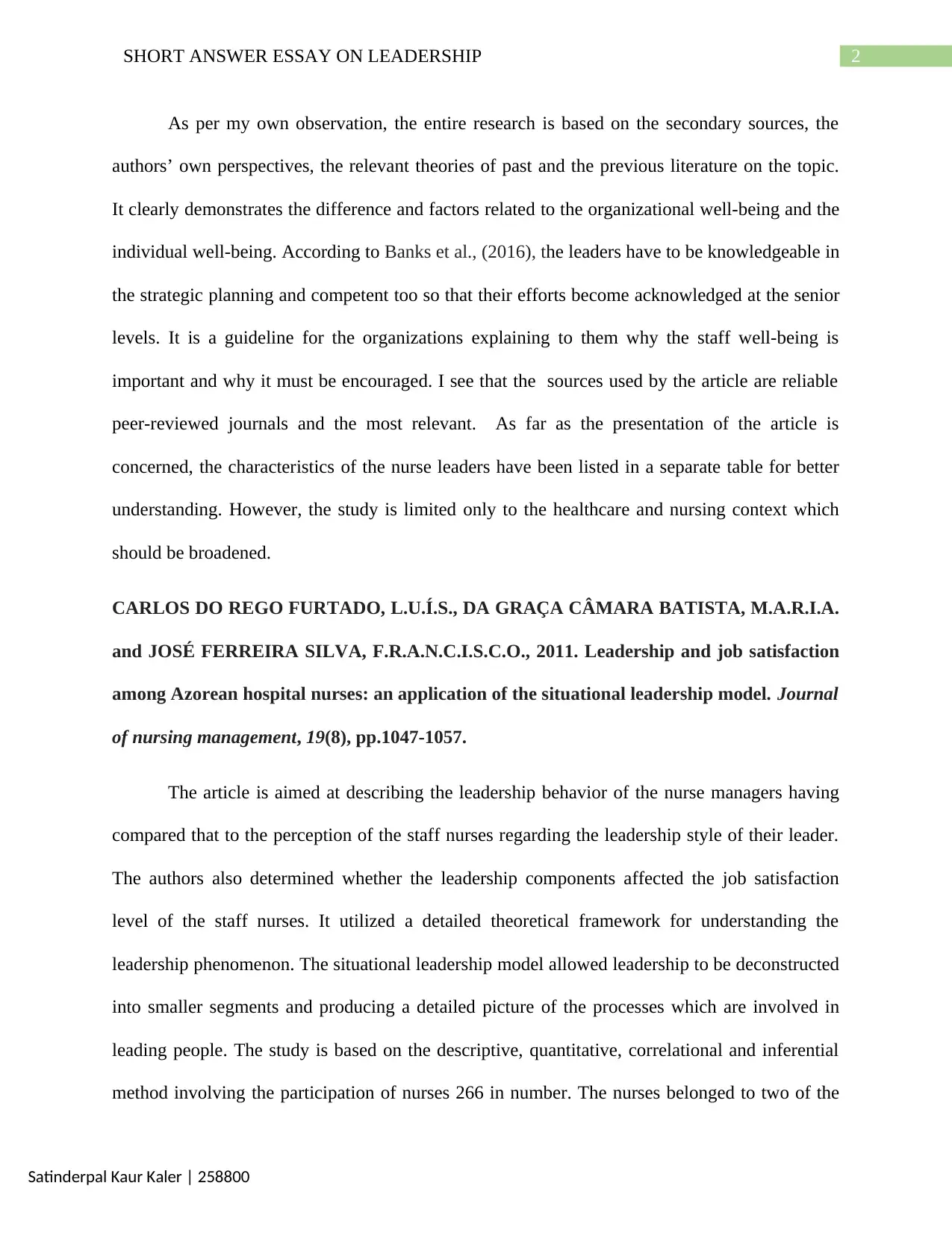
2SHORT ANSWER ESSAY ON LEADERSHIP
Satinderpal Kaur Kaler | 258800
As per my own observation, the entire research is based on the secondary sources, the
authors’ own perspectives, the relevant theories of past and the previous literature on the topic.
It clearly demonstrates the difference and factors related to the organizational well-being and the
individual well-being. According to Banks et al., (2016), the leaders have to be knowledgeable in
the strategic planning and competent too so that their efforts become acknowledged at the senior
levels. It is a guideline for the organizations explaining to them why the staff well-being is
important and why it must be encouraged. I see that the sources used by the article are reliable
peer-reviewed journals and the most relevant. As far as the presentation of the article is
concerned, the characteristics of the nurse leaders have been listed in a separate table for better
understanding. However, the study is limited only to the healthcare and nursing context which
should be broadened.
CARLOS DO REGO FURTADO, L.U.Í.S., DA GRAÇA CÂMARA BATISTA, M.A.R.I.A.
and JOSÉ FERREIRA SILVA, F.R.A.N.C.I.S.C.O., 2011. Leadership and job satisfaction
among Azorean hospital nurses: an application of the situational leadership model. Journal
of nursing management, 19(8), pp.1047-1057.
The article is aimed at describing the leadership behavior of the nurse managers having
compared that to the perception of the staff nurses regarding the leadership style of their leader.
The authors also determined whether the leadership components affected the job satisfaction
level of the staff nurses. It utilized a detailed theoretical framework for understanding the
leadership phenomenon. The situational leadership model allowed leadership to be deconstructed
into smaller segments and producing a detailed picture of the processes which are involved in
leading people. The study is based on the descriptive, quantitative, correlational and inferential
method involving the participation of nurses 266 in number. The nurses belonged to two of the
Satinderpal Kaur Kaler | 258800
As per my own observation, the entire research is based on the secondary sources, the
authors’ own perspectives, the relevant theories of past and the previous literature on the topic.
It clearly demonstrates the difference and factors related to the organizational well-being and the
individual well-being. According to Banks et al., (2016), the leaders have to be knowledgeable in
the strategic planning and competent too so that their efforts become acknowledged at the senior
levels. It is a guideline for the organizations explaining to them why the staff well-being is
important and why it must be encouraged. I see that the sources used by the article are reliable
peer-reviewed journals and the most relevant. As far as the presentation of the article is
concerned, the characteristics of the nurse leaders have been listed in a separate table for better
understanding. However, the study is limited only to the healthcare and nursing context which
should be broadened.
CARLOS DO REGO FURTADO, L.U.Í.S., DA GRAÇA CÂMARA BATISTA, M.A.R.I.A.
and JOSÉ FERREIRA SILVA, F.R.A.N.C.I.S.C.O., 2011. Leadership and job satisfaction
among Azorean hospital nurses: an application of the situational leadership model. Journal
of nursing management, 19(8), pp.1047-1057.
The article is aimed at describing the leadership behavior of the nurse managers having
compared that to the perception of the staff nurses regarding the leadership style of their leader.
The authors also determined whether the leadership components affected the job satisfaction
level of the staff nurses. It utilized a detailed theoretical framework for understanding the
leadership phenomenon. The situational leadership model allowed leadership to be deconstructed
into smaller segments and producing a detailed picture of the processes which are involved in
leading people. The study is based on the descriptive, quantitative, correlational and inferential
method involving the participation of nurses 266 in number. The nurses belonged to two of the
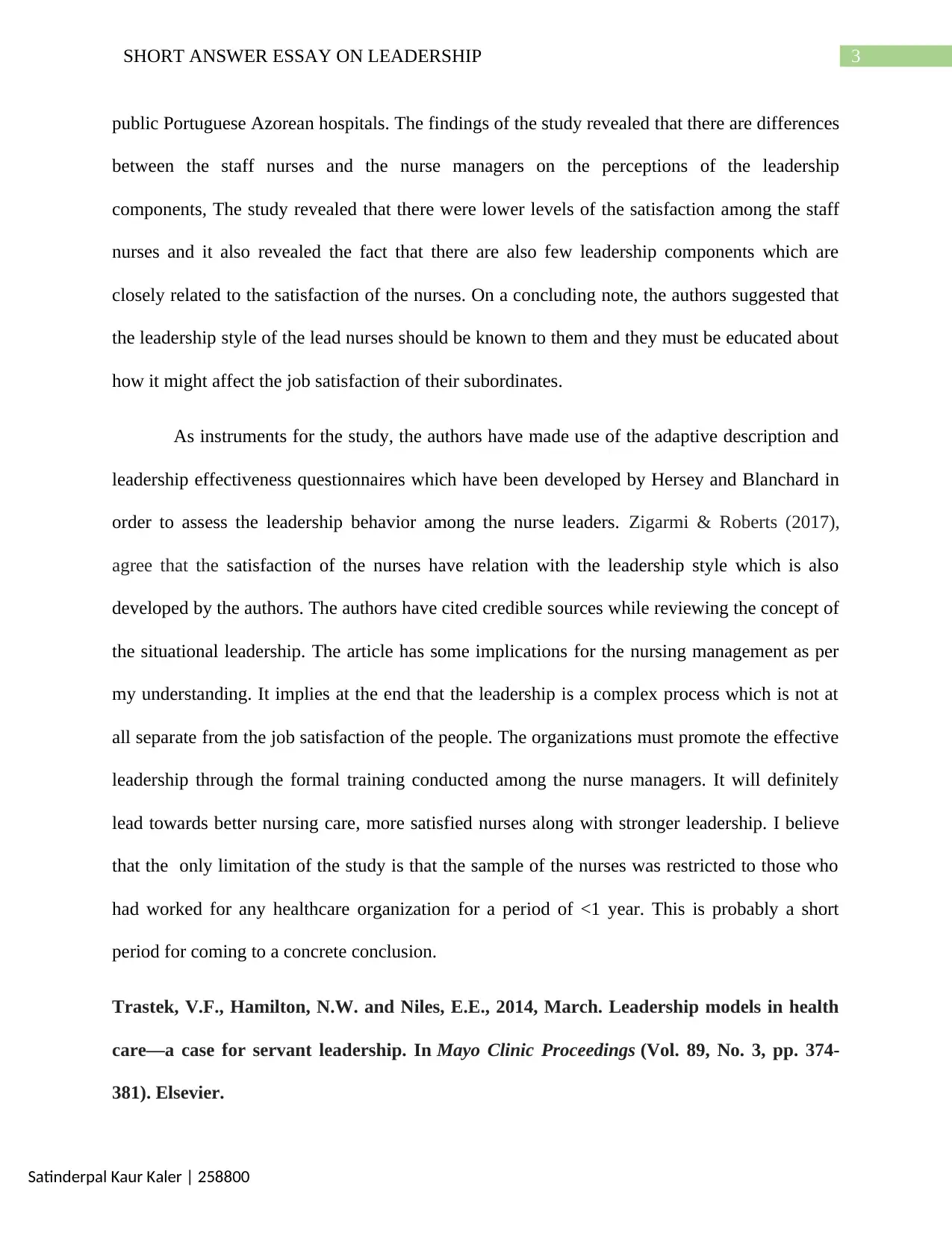
3SHORT ANSWER ESSAY ON LEADERSHIP
Satinderpal Kaur Kaler | 258800
public Portuguese Azorean hospitals. The findings of the study revealed that there are differences
between the staff nurses and the nurse managers on the perceptions of the leadership
components, The study revealed that there were lower levels of the satisfaction among the staff
nurses and it also revealed the fact that there are also few leadership components which are
closely related to the satisfaction of the nurses. On a concluding note, the authors suggested that
the leadership style of the lead nurses should be known to them and they must be educated about
how it might affect the job satisfaction of their subordinates.
As instruments for the study, the authors have made use of the adaptive description and
leadership effectiveness questionnaires which have been developed by Hersey and Blanchard in
order to assess the leadership behavior among the nurse leaders. Zigarmi & Roberts (2017),
agree that the satisfaction of the nurses have relation with the leadership style which is also
developed by the authors. The authors have cited credible sources while reviewing the concept of
the situational leadership. The article has some implications for the nursing management as per
my understanding. It implies at the end that the leadership is a complex process which is not at
all separate from the job satisfaction of the people. The organizations must promote the effective
leadership through the formal training conducted among the nurse managers. It will definitely
lead towards better nursing care, more satisfied nurses along with stronger leadership. I believe
that the only limitation of the study is that the sample of the nurses was restricted to those who
had worked for any healthcare organization for a period of <1 year. This is probably a short
period for coming to a concrete conclusion.
Trastek, V.F., Hamilton, N.W. and Niles, E.E., 2014, March. Leadership models in health
care—a case for servant leadership. In Mayo Clinic Proceedings (Vol. 89, No. 3, pp. 374-
381). Elsevier.
Satinderpal Kaur Kaler | 258800
public Portuguese Azorean hospitals. The findings of the study revealed that there are differences
between the staff nurses and the nurse managers on the perceptions of the leadership
components, The study revealed that there were lower levels of the satisfaction among the staff
nurses and it also revealed the fact that there are also few leadership components which are
closely related to the satisfaction of the nurses. On a concluding note, the authors suggested that
the leadership style of the lead nurses should be known to them and they must be educated about
how it might affect the job satisfaction of their subordinates.
As instruments for the study, the authors have made use of the adaptive description and
leadership effectiveness questionnaires which have been developed by Hersey and Blanchard in
order to assess the leadership behavior among the nurse leaders. Zigarmi & Roberts (2017),
agree that the satisfaction of the nurses have relation with the leadership style which is also
developed by the authors. The authors have cited credible sources while reviewing the concept of
the situational leadership. The article has some implications for the nursing management as per
my understanding. It implies at the end that the leadership is a complex process which is not at
all separate from the job satisfaction of the people. The organizations must promote the effective
leadership through the formal training conducted among the nurse managers. It will definitely
lead towards better nursing care, more satisfied nurses along with stronger leadership. I believe
that the only limitation of the study is that the sample of the nurses was restricted to those who
had worked for any healthcare organization for a period of <1 year. This is probably a short
period for coming to a concrete conclusion.
Trastek, V.F., Hamilton, N.W. and Niles, E.E., 2014, March. Leadership models in health
care—a case for servant leadership. In Mayo Clinic Proceedings (Vol. 89, No. 3, pp. 374-
381). Elsevier.
Secure Best Marks with AI Grader
Need help grading? Try our AI Grader for instant feedback on your assignments.
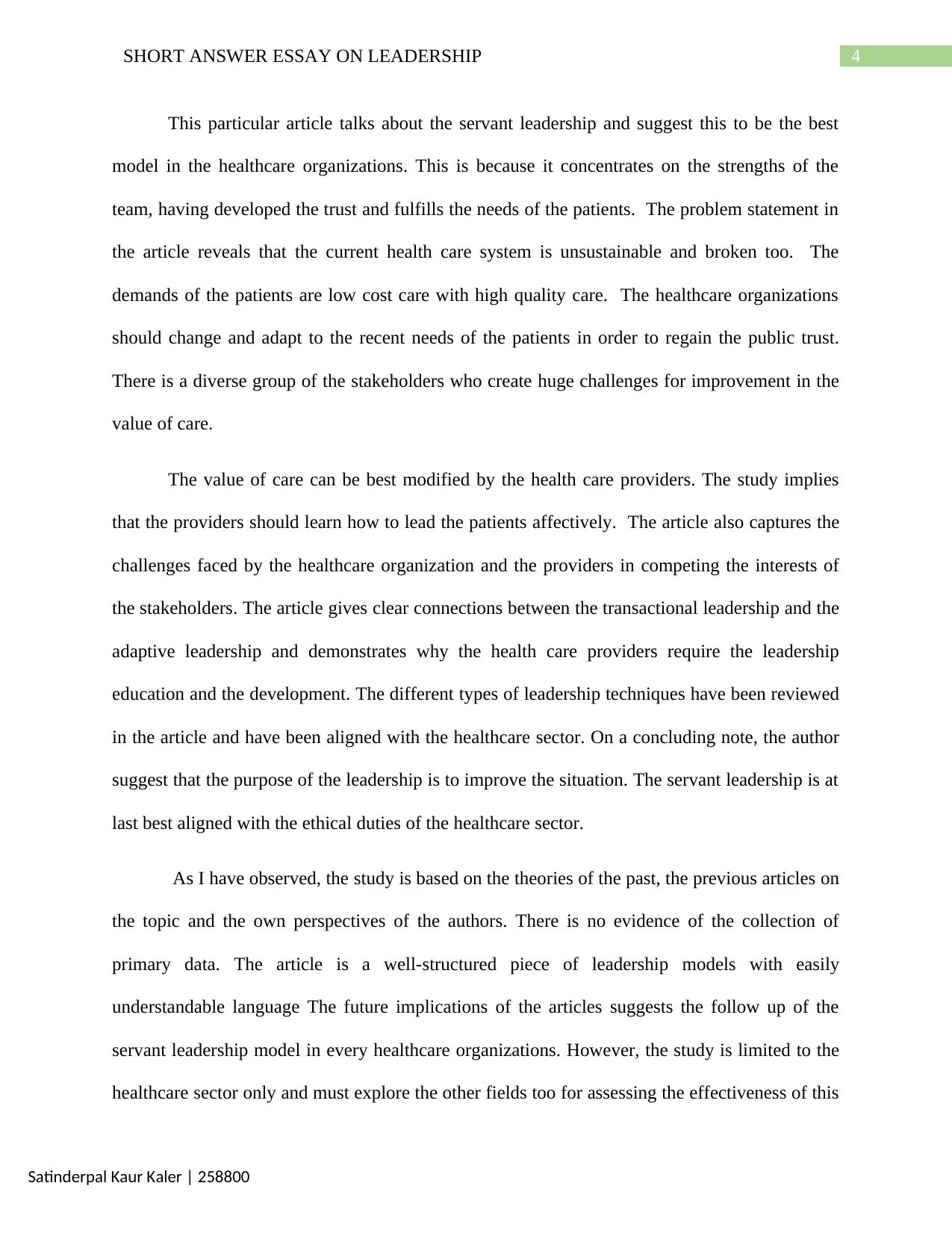
4SHORT ANSWER ESSAY ON LEADERSHIP
Satinderpal Kaur Kaler | 258800
This particular article talks about the servant leadership and suggest this to be the best
model in the healthcare organizations. This is because it concentrates on the strengths of the
team, having developed the trust and fulfills the needs of the patients. The problem statement in
the article reveals that the current health care system is unsustainable and broken too. The
demands of the patients are low cost care with high quality care. The healthcare organizations
should change and adapt to the recent needs of the patients in order to regain the public trust.
There is a diverse group of the stakeholders who create huge challenges for improvement in the
value of care.
The value of care can be best modified by the health care providers. The study implies
that the providers should learn how to lead the patients affectively. The article also captures the
challenges faced by the healthcare organization and the providers in competing the interests of
the stakeholders. The article gives clear connections between the transactional leadership and the
adaptive leadership and demonstrates why the health care providers require the leadership
education and the development. The different types of leadership techniques have been reviewed
in the article and have been aligned with the healthcare sector. On a concluding note, the author
suggest that the purpose of the leadership is to improve the situation. The servant leadership is at
last best aligned with the ethical duties of the healthcare sector.
As I have observed, the study is based on the theories of the past, the previous articles on
the topic and the own perspectives of the authors. There is no evidence of the collection of
primary data. The article is a well-structured piece of leadership models with easily
understandable language The future implications of the articles suggests the follow up of the
servant leadership model in every healthcare organizations. However, the study is limited to the
healthcare sector only and must explore the other fields too for assessing the effectiveness of this
Satinderpal Kaur Kaler | 258800
This particular article talks about the servant leadership and suggest this to be the best
model in the healthcare organizations. This is because it concentrates on the strengths of the
team, having developed the trust and fulfills the needs of the patients. The problem statement in
the article reveals that the current health care system is unsustainable and broken too. The
demands of the patients are low cost care with high quality care. The healthcare organizations
should change and adapt to the recent needs of the patients in order to regain the public trust.
There is a diverse group of the stakeholders who create huge challenges for improvement in the
value of care.
The value of care can be best modified by the health care providers. The study implies
that the providers should learn how to lead the patients affectively. The article also captures the
challenges faced by the healthcare organization and the providers in competing the interests of
the stakeholders. The article gives clear connections between the transactional leadership and the
adaptive leadership and demonstrates why the health care providers require the leadership
education and the development. The different types of leadership techniques have been reviewed
in the article and have been aligned with the healthcare sector. On a concluding note, the author
suggest that the purpose of the leadership is to improve the situation. The servant leadership is at
last best aligned with the ethical duties of the healthcare sector.
As I have observed, the study is based on the theories of the past, the previous articles on
the topic and the own perspectives of the authors. There is no evidence of the collection of
primary data. The article is a well-structured piece of leadership models with easily
understandable language The future implications of the articles suggests the follow up of the
servant leadership model in every healthcare organizations. However, the study is limited to the
healthcare sector only and must explore the other fields too for assessing the effectiveness of this
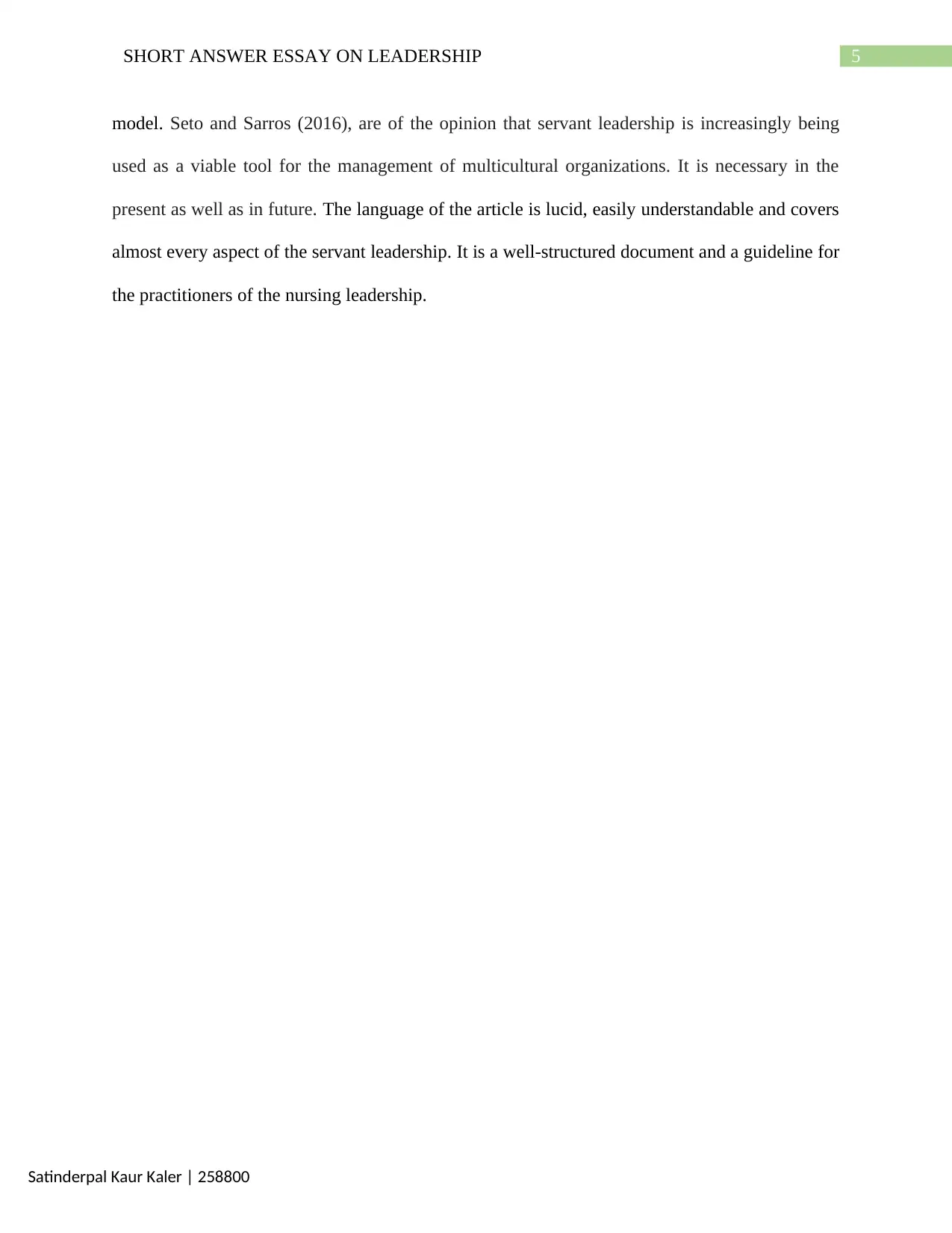
5SHORT ANSWER ESSAY ON LEADERSHIP
Satinderpal Kaur Kaler | 258800
model. Seto and Sarros (2016), are of the opinion that servant leadership is increasingly being
used as a viable tool for the management of multicultural organizations. It is necessary in the
present as well as in future. The language of the article is lucid, easily understandable and covers
almost every aspect of the servant leadership. It is a well-structured document and a guideline for
the practitioners of the nursing leadership.
Satinderpal Kaur Kaler | 258800
model. Seto and Sarros (2016), are of the opinion that servant leadership is increasingly being
used as a viable tool for the management of multicultural organizations. It is necessary in the
present as well as in future. The language of the article is lucid, easily understandable and covers
almost every aspect of the servant leadership. It is a well-structured document and a guideline for
the practitioners of the nursing leadership.
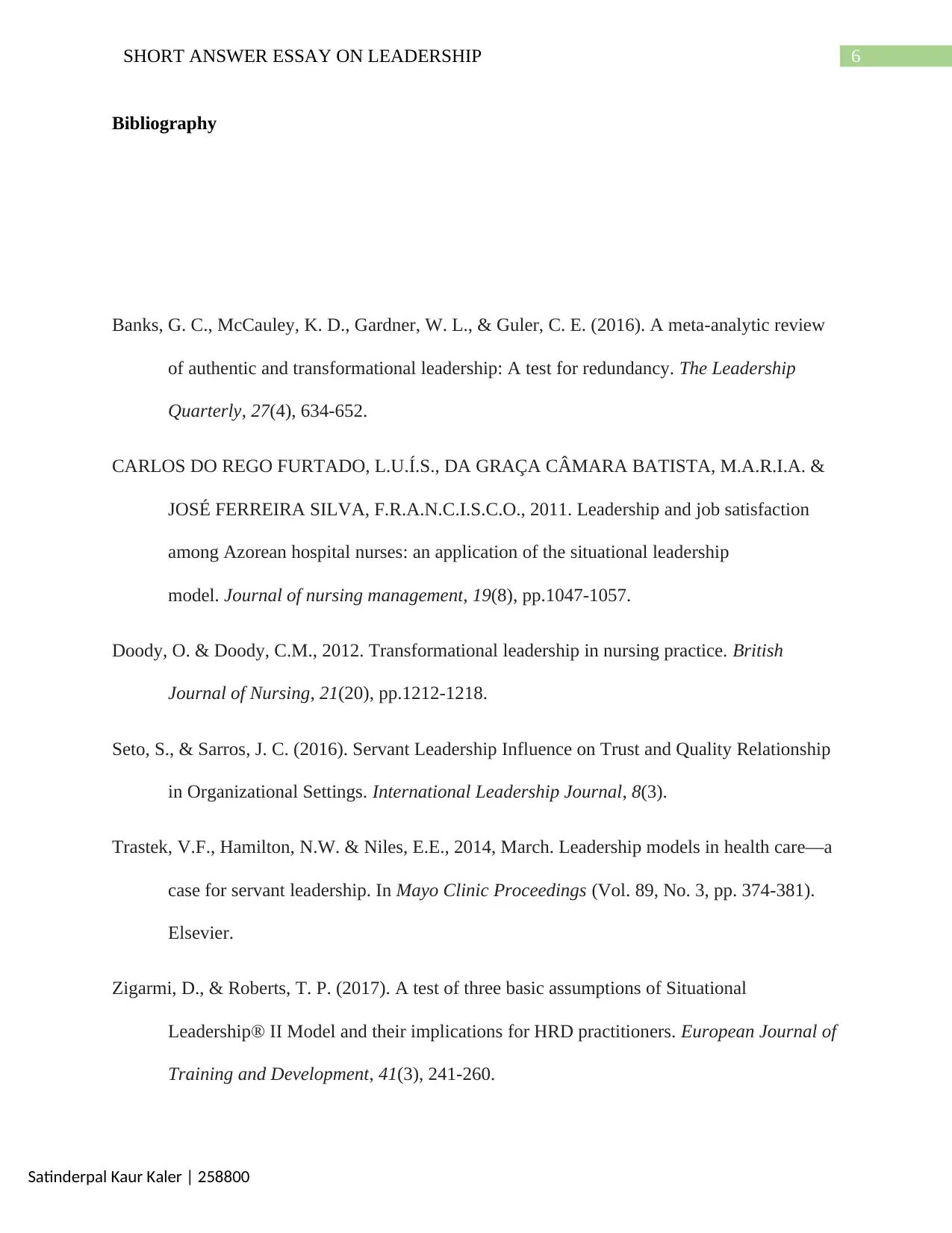
6SHORT ANSWER ESSAY ON LEADERSHIP
Satinderpal Kaur Kaler | 258800
Bibliography
Banks, G. C., McCauley, K. D., Gardner, W. L., & Guler, C. E. (2016). A meta-analytic review
of authentic and transformational leadership: A test for redundancy. The Leadership
Quarterly, 27(4), 634-652.
CARLOS DO REGO FURTADO, L.U.Í.S., DA GRAÇA CÂMARA BATISTA, M.A.R.I.A. &
JOSÉ FERREIRA SILVA, F.R.A.N.C.I.S.C.O., 2011. Leadership and job satisfaction
among Azorean hospital nurses: an application of the situational leadership
model. Journal of nursing management, 19(8), pp.1047-1057.
Doody, O. & Doody, C.M., 2012. Transformational leadership in nursing practice. British
Journal of Nursing, 21(20), pp.1212-1218.
Seto, S., & Sarros, J. C. (2016). Servant Leadership Influence on Trust and Quality Relationship
in Organizational Settings. International Leadership Journal, 8(3).
Trastek, V.F., Hamilton, N.W. & Niles, E.E., 2014, March. Leadership models in health care—a
case for servant leadership. In Mayo Clinic Proceedings (Vol. 89, No. 3, pp. 374-381).
Elsevier.
Zigarmi, D., & Roberts, T. P. (2017). A test of three basic assumptions of Situational
Leadership® II Model and their implications for HRD practitioners. European Journal of
Training and Development, 41(3), 241-260.
Satinderpal Kaur Kaler | 258800
Bibliography
Banks, G. C., McCauley, K. D., Gardner, W. L., & Guler, C. E. (2016). A meta-analytic review
of authentic and transformational leadership: A test for redundancy. The Leadership
Quarterly, 27(4), 634-652.
CARLOS DO REGO FURTADO, L.U.Í.S., DA GRAÇA CÂMARA BATISTA, M.A.R.I.A. &
JOSÉ FERREIRA SILVA, F.R.A.N.C.I.S.C.O., 2011. Leadership and job satisfaction
among Azorean hospital nurses: an application of the situational leadership
model. Journal of nursing management, 19(8), pp.1047-1057.
Doody, O. & Doody, C.M., 2012. Transformational leadership in nursing practice. British
Journal of Nursing, 21(20), pp.1212-1218.
Seto, S., & Sarros, J. C. (2016). Servant Leadership Influence on Trust and Quality Relationship
in Organizational Settings. International Leadership Journal, 8(3).
Trastek, V.F., Hamilton, N.W. & Niles, E.E., 2014, March. Leadership models in health care—a
case for servant leadership. In Mayo Clinic Proceedings (Vol. 89, No. 3, pp. 374-381).
Elsevier.
Zigarmi, D., & Roberts, T. P. (2017). A test of three basic assumptions of Situational
Leadership® II Model and their implications for HRD practitioners. European Journal of
Training and Development, 41(3), 241-260.
Paraphrase This Document
Need a fresh take? Get an instant paraphrase of this document with our AI Paraphraser

7SHORT ANSWER ESSAY ON LEADERSHIP
Satinderpal Kaur Kaler | 258800
Satinderpal Kaur Kaler | 258800
1 out of 8
Related Documents
Your All-in-One AI-Powered Toolkit for Academic Success.
+13062052269
info@desklib.com
Available 24*7 on WhatsApp / Email
![[object Object]](/_next/static/media/star-bottom.7253800d.svg)
Unlock your academic potential
© 2024 | Zucol Services PVT LTD | All rights reserved.





